
New double raschel machine for lightweight spacer fabrics
As a leading manufacturer of warp knitting and warp preparation machines, Karl Mayer will be exhibiting at this year's ITMA trade fair from 22 to 29 September in Barcelona and for the first time, all of the company's business units will be represented on the same 1400 square metre stand. In the Lace sector, Karl Mayer will be showing the new, highly productive Textronic Lace TL 59/1/24 and the Jacquardtronic Lace JL 40/1 F, which th

26th July 2011
Knitting Industry
|
Obertshausen
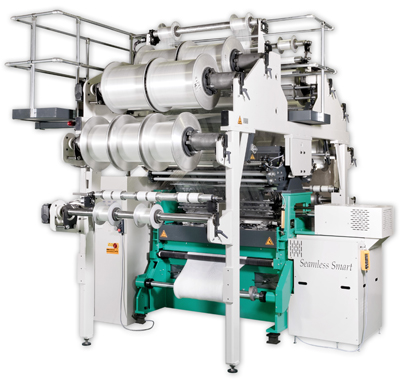
As a leading manufacturer of warp knitting and warp preparation machines, Karl Mayer will be exhibiting at this year's ITMA trade fair from 22 to 29 September in Barcelona and for the first time, all of the company's business units will be represented on the same 1400 square metre stand.
In the Lace sector, Karl Mayer will be showing the new, highly productive Textronic Lace TL 59/1/24 and the Jacquardtronic Lace JL 40/1 F, which the company says is currently in high demand for producing soft-shape lace.
On the topic of Elastic, the company will be showing the new RSJ 4/1, a machine with enhanced performance for producing attractive warp knits with a lace look.
Karl Mayer will also be showing how the DJ 6/2 EL and the Positive Patternbeam Drive (PPD) can be used to produce 3D panties developed by the company, which feature a range of functional characteristics. The third machine in the group for producing stretch fabrics is the HKS 2-3 E, which has a unique new ultrafine gauge of E 50.
"This is a real breakthrough in the efficient production of ultrafine, stretch warp knits for the lingerie and clothing sector," a Karl Mayer press statement said yesterday.
Karl Mayer also says that the completely newly developed HKS 3-1 is a ‘must see' for all manufacturers operating in the Rigid and Semi technical sector. The high-speed machine is the latest in the HKS machine series to be changed over to the successful CFP concept, and aims to set new standards in terms of speed among the three-bar tricot machines.
Karl Mayer's Warp Preparation business unit will show the new Multi-MATIC. One of its new features is a completely new yarn management system, which can be used to efficiently and flexibly produce sample warps as well as production warps of average running length. The new PRO SIZE box is also designed to offer maximum productivity and flexibility, especially when setting the yarn density.
"The particular key to success here is the use of the latest application technology and intelligently designed application zones," the company says. The warp preparation machines on show at the exhibition will be complemented by various holding devices and yarn tensioners, such as the Rot-O-Tense.
In Barcelona, Karl Mayer's Technical Textiles business unit will be showing a laying module on the Malitronic MULTIAXIAL C&L for processing spread-out carbon tapes from a flanged spool. The flanged spool is produced by an external fibre spreading unit, an off-line processing technique that claims to increase productivity considerably compared to conventional processes when producing high-quality multiaxial textiles from heavy tow materials.
The following report gives more detail on what visitors can expect from Karl Mayer in Barcelona.
At the ITMA a DJ 6/2 EL with integrated Positive Patternbeam Drive (PPD) will be exhibited. This innovative system actively supplies the knitting process with additional yarns from pattern beams at three locations, which is said to enhance the functional aspects of the textile products.
In Barcelona, the DJ 6/2 will be producing 3D shapewear panties developed by Karl Mayer in a gauge of E 28, and will be incorporating additional elastane into specific zones in order to do this. The leg seams and the waist opening with its border are incorporated directly into the garment so that they do not roll over unattractively, and create smooth transition points between the garment and the body.
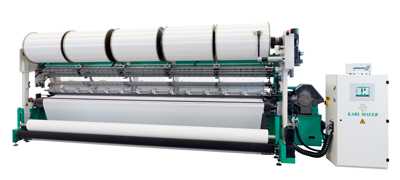 HKS 3-1 now available with CFP
HKS 3-1 now available with CFPKarl Mayer has changed over its HKS 3-1 machine to incorporate CFP (carbon fibre) components to coincide with this year's ITMA exhibition. This latest innovation is the final stage in the integration of this lightweight, stable material into its range of high-speed tricot machines. The result of this strategy, Karl Mayer says, is that the HKS 3-1 can now operate at much higher speeds and with greater temperature stability.
According to Karl Mayer, in order to change over the entire machine to operating at these higher speeds, all the movement sequences at the knitting point were harmonised more precisely with each other, and specific details were optimised. For example, the machine frame was upgraded by carrying out extensive computer-aided calculations and the yarn guide and tensioning devices were also modified.
In Barcelona, Karl Mayer will be showing an HKS 3-1 which, with a working width of 210 inches, a gauge of E 28 and its new speed profile, which the company says is an outstanding example of a three-bar tricot machine.
Karl Mayer says gauges of E 32, E 40 and E 50 are state-of-the-art when producing lightweight, opaque, stretch fabrics and these exceptionally fine stitch densities have led to the development of completely new fabric characteristics.
"In Barcelona, an HKS 2-3 E having a working width of 130 inches and a gauge of E 50 will be producing an exceptionally delicate, silky, micro-knitted fabric at its usual, impressive, high performance rate," the German company says. The machine can reach speeds more than 3000 rpm.
According to Karl Mayer light and airy lingerie fabrics with a lace look and sportswear incorporating functional zones are in increasing demand, and this demand can be stimulated even more by the completely newly developed RSJ 4/1 machine.
"The Rascheltronic has been specifically optimised to make it considerably faster and more creative than its predecessor," Karl Mayer says.
The yarn feed system for the jacquard bars has been expressly modified to increase the range of patterns that can be produced. The yarns used to be delivered from a warp beam all together in a single assembly, but the yarns are now fed to both jacquard bars from two warp beams that are arranged as a mirror image in relation to each other.
Karl Mayer says, the separate feed arrangement enables the jacquard bars to execute opposite movements and thus to work patterned net grounds, for example.
"These fabrics, which have already become successfully established on the market as spot net fabrics, can now be produced much more efficiently on the RSJ 4/1. This innovative Rascheltronic offers an impressive and more attractive price-performance ratio, in comparison with jacquard circular weft knitting machines," Karl Mayer says.
At ITMA in Barcelona the Rascheltronic, with a working width of 130 inches, will be producing a lightweight fabric for the clothing sector in a gauge of E 28.
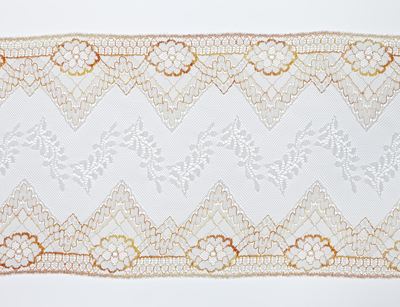 The JL 40/1 F for functional yet exquisite lace
The JL 40/1 F for functional yet exquisite laceA newly configured JL 40/1 will also be shown.
"The JL 40/1 F produces lingerie fabrics with light-control effects, a soft handle and a low weight, but they also feature all the typical elements of fine, conventional lace. The JL 40/1 F has been equipped with a special bar configuration to enable it to produce fabrics with all these many characteristics," Karl Mayer explains.
This new arrangement and the possibilities offered by the split yarn threading-in arrangement, mean that the jacquard guide bars can work to form stitches and smooth panel goods having light-control characteristics, without working the conventional pillar stitch/weft construction.
The jacquard bars also enable simple yet effective spotted patterns to be worked in the dense, functional fabric bands. According to Karl Mayer, fine lace fabrics with smart, comfortable compression characteristics are produced, which feature entwined floral and decorative elements as produced on multibar machines and which are used in the tapes and ribbons of lace lingerie.
At the ITMA exhibition, the JL 40/1 F, with a width of 134 inches and a gauge of E 28, will be producing a sample of this fabric. The machine is designed to operate at a maximum speed of 750 rpm.
The new TL 59/1/24 is designed to bridge the gap between the TL 43/1/24 and the TL 71/1/36. It is based on the same principles as its predecessor, but Karl Mayer says it shows some improvements in terms of flexibility and efficiency. This new machine is available in a gauge of E 24 as well as in a gauge of E 28.
The TL 59/1/24 can also achieve an enhanced maximum speed which is said to increase the price-performance ratio by 20 % compared to its predecessor. This success is said to be mainly the result of integrating the well-tried string bar concept and the efficient KAMCOS system. As an optional extra, the machine can also be equipped with the Positive Patternbeam Drive (PPD) for active, tension-controlled yarn feeding.
At ITMA in Barcelona, the new TL 59/1/24, with a width of 130 inches, will be producing sheer lace ribbons with a delicate pattern.
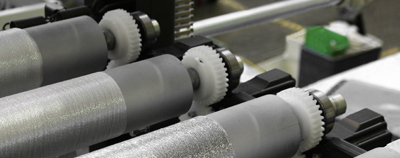 Positive Patternbeam Drive (PPD) -extending the performance profile of raschel machines
Positive Patternbeam Drive (PPD) -extending the performance profile of raschel machines
The Positive Patternbeam Drive (PPD) is a motor-driven delivery unit. It actively feeds yarn from the pattern beam to the knitting process and therefore offers gentle handling especially when processing difficult fancy yarns at high speeds. Karl Mayer says there is now no need to restrict the speed to 600rpm.
Further claimed advantages are a fabric having an exceptionally uniform appearance and minimal downtimes compared to the passive system.
Maximum machine availability has been achieved, especially by using pattern beams having a package diameter of 14 cm, whose running time, is said to have been increased by a maximum of about 50%.
"However, above all, the PPD system dispenses with the time-consuming processes involved in balancing and rebalancing the pattern beams," Karl Mayer says.
The PPD will be shown in use on various machines being exhibited at the ITMA exhibition.
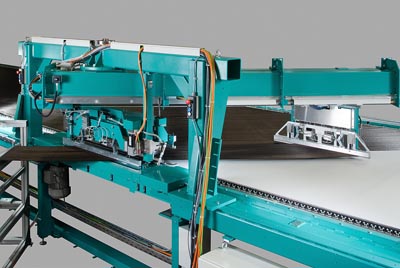 Malitronic MULTIAXIAL improved for specific applications
Malitronic MULTIAXIAL improved for specific applicationsIn the area of multiaxial warp knitting machines Karl Mayer is showing a weft insertion system for the on-line processing of cut-to-length tapes for use in the processing of spread-out carbon material - the Malitronic MULTIAXIAL C&L (Cut and Lay). So far, Karl Mayer explains, the spreading has been carried out in a closed process straight from the creel.
Karl Mayer has now separated the spreading process and the textile manufacturing process in order to process heavy-tow-materials effectively with high quality, and to improve energy consumption and increase productivity and working width.
The key feature of this new system is an external Fibre Spreading Line (FSL), which actively pulls the carbon tapes from the bobbins on the creel, homogenises the several rovings in order to width and grammage, merges them as defined together and winds the originated tape onto a double-flanged bobbin.
The bobbin has a maximum width of 600 mm. The yarn package, which is similar to a sectional warp beam, is then fed to the Malitronic MULTIAXIAL C&L. The weft carriage of the machine picks up the spread carbon fibre tape and lays it diagonally at a working width of 100 inches, for example.
Karl Mayer claims that compared to the on-line process, this two-stage process enables higher production speeds to be reached and energy to be used more efficiently.
Karl Mayer is showing a laying module at the exhibition, where it will be demonstrating the principles involved in laying the material that has been supplied from the double-flanged bobbin.

Business intelligence for the fibre, textiles and apparel industries: technologies, innovations, markets, investments, trade policy, sourcing, strategy...
Find out more